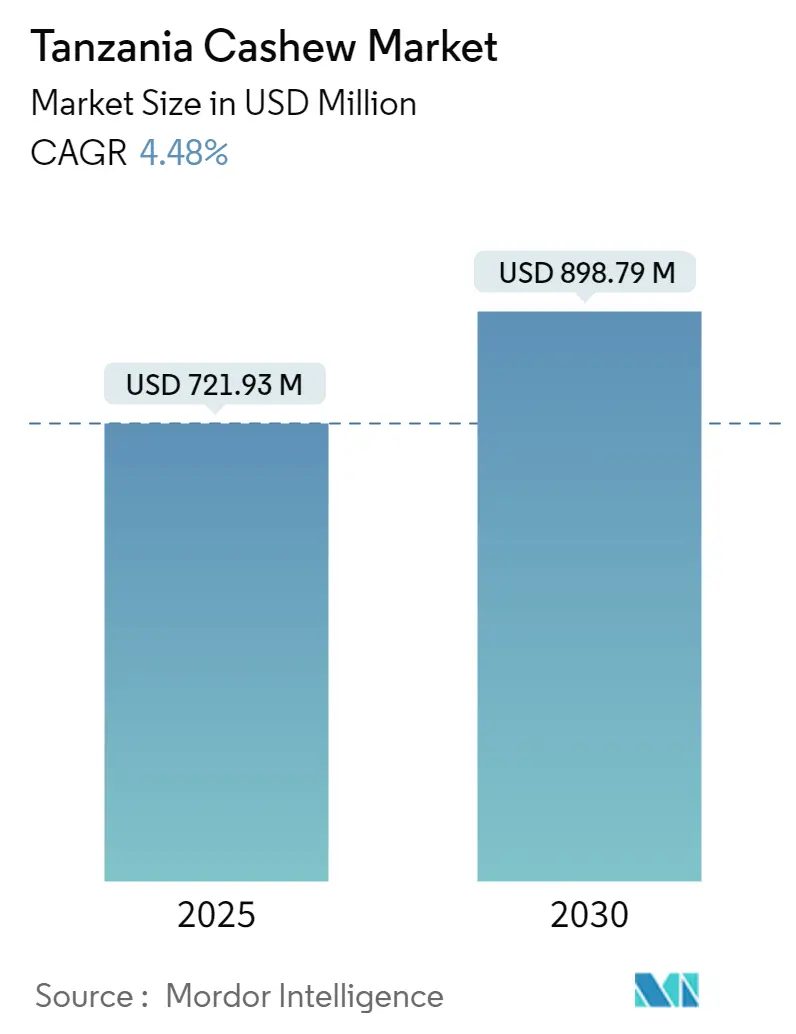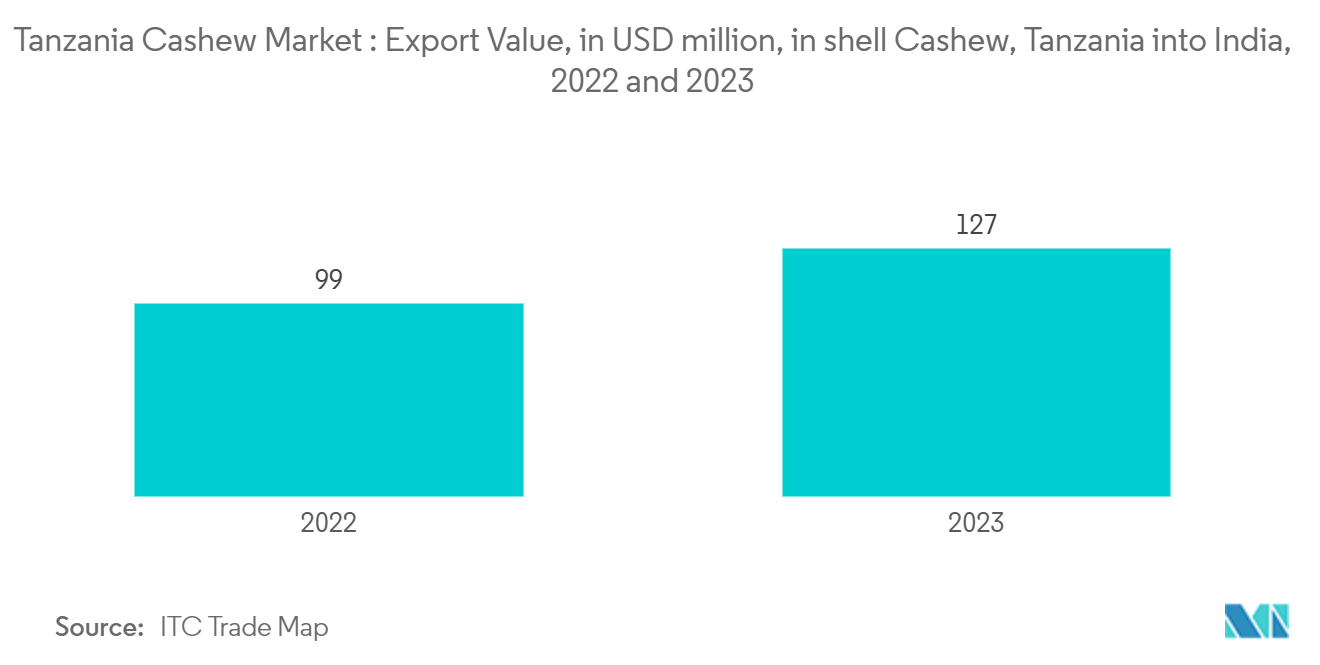Tanzania Cashew Market Size

| Study Period | 2019 - 2030 |
| Base Year For Estimation | 2024 |
| Forecast Data Period | 2025 - 2030 |
| Historical Data Period | 2019 - 2023 |
| Market Size (2025) | USD 721.93 Million |
| Market Size (2030) | USD 898.79 Million |
| CAGR (2025 - 2030) | 4.48 % |
Tanzania Cashew Market Analysis
The Tanzania Cashew Market size is estimated at USD 721.93 million in 2025, and is expected to reach USD 898.79 million by 2030, at a CAGR of 4.48% during the forecast period (2025-2030).
The cashew market in Tanzania is integral to the country's agricultural sector, significantly impacting both production and export activities. Cashews, primarily grown in coastal regions, are a key cash crop, making Tanzania a leading producer in Africa. The market's growth is driven by better market conditions, increased investments in processing facilities, and a wider range of value-added products. Tanzanian companies are expanding their offerings to include roasted cashews, cashew butter, and cashew milk, catering to health-conscious consumers. In 2022, the Tanzania Investment Center (TIC) collaborated with local investors to establish cashew nut processing factories. This initiative aims to enhance international exports of value-added cashew products, increase export revenues, and create employment opportunities for Tanzanians.
The Tanzanian government is actively supporting the development of the cashew value chain by promoting investments in processing, adopting modern technology, and adding local value. In 2023, CARE International, in partnership with Danida Markets Development Partnerships (DMDP) and commercial partner Out-Growers Tanzania Limited, launched a four-year project with a budget of 10 million Danish Kroner (USD 1.4 million). This project aims to directly engage 3,000 smallholder cashew farmers, involving them in Farmer Field and Business Schools (FFBS), Village Savings and Lending Associations (VSLAs), and the Agricultural Marketing Cooperative Society (AMCOs) of Duga. A notable aspect of this initiative is that farmers, through their Agricultural Marketing Cooperative Society (AMCOS), can co-own a cashew processing facility in partnership with Out-Growers Tanzania Limited, under the newly formed Out Growers KILIMO Industry Sigaya Limited, supporting market growth. Despite these market drivers, challenges such as climate change, market fluctuations, and infrastructural shortcomings may hinder the market. Nevertheless, the combined importance of production, export potential, rising demand for value-added products, and proactive government initiatives are expected to drive market growth in the coming years.
Tanzania Cashew Market Trends
Government Support Boosts Cashew Production
Tanzania stands out as a leading cashew producer in Africa, with key growing regions being Mtwara, Lindi, Ruvuma, and Tanga. Notably, Mtwara and Lindi account for over 87% of the nation's cashew output. These areas, characterized by warm temperatures and dry spells, provide optimal conditions for cashew cultivation. For over two million smallholder farmers, particularly in rural and coastal regions, cashew farming serves as a crucial source of income. The Cashewnut Board of Tanzania highlights the country's vast potential, not only to boost production but also to elevate the value of domestically processed cashew nuts from the current 10% and to make use of by-products. To realize this vision, stakeholders including the government, NGOs, and private entities are championing modern farming techniques. These include the use of superior seeds, pest management practices, and enhanced cultivation training. As per the Cashewnut Board of Tanzania (CBT), the allocation for subsidized agricultural inputs for cashew nuts surged to Sh188.99 billion (USD 330 million) in the 2023/24 season, up from Sh96.26 billion (USD 170 million) in the previous season.
In Tanzania, cashews are predominantly cultivated as a cash crop, with premium prices commanded by high-quality, larger nuts in both domestic and global markets. These lucrative export prices account for 10-15% of the nation's foreign exchange earnings. In response, the Tanzanian government is rolling out supportive policies to amplify production. A notable initiative empowers local cashew processors to purchase directly from farmers, enhancing both their capacity and sustainability. With an ambitious target, the government aims to triple cashew production to reach 1 million metric tons by 2025. Data from FAOSTAT reveals a steady rise in production, climbing from 210 thousand metric tons in 2021 to 216 thousand metric tons in 2022. Given the ongoing governmental backing, the market is poised for substantial growth in the coming years.

Rising Export Potential of Cashewnuts
Tanzania is a leading producer of cashew nuts in Africa and a significant global exporter of raw cashew nuts. According to the ITC trade map, Tanzania ranks as the world's fourth-largest cashew exporter. The cashew export sector is vital to Tanzania's economy, boosting foreign exchange earnings and supporting millions of smallholder farmers. Major importers of Tanzanian cashews include India, Vietnam, China, and the Netherlands. Tanzania primarily exports raw cashew nuts, with limited local processing. The harvested nuts are dried and packaged before export, allowing importing nations to capture much of the value by processing these nuts into cashew kernels or other products.
During the study period, Tanzanian cashew nut exports saw a significant increase. ITC trade map data shows exports rose from 154 thousand metric tons in 2021 to 219 thousand metric tons in 2022. This growth is largely driven by increased imports into India. For instance, the monetary value of these imports into India also climbed from USD 99 million in 2022 to USD 127 million in 2023. This parallel growth in import value is anticipated to drive market expansion during the forecast period.
While traditional markets like India and Vietnam remain crucial, Tanzania has opportunities to diversify its export destinations. Emerging markets in the Middle East, Asia, and Europe are showing increasing demand for cashews, offering lucrative prospects for Tanzanian exporters. To strengthen its international market presence, Tanzania has started channeling its cashew nut sales through the newly established Tanzania Mercantile Exchange (TMX). This government-supported initiative will launch special auction markets for raw cashew nuts in early October 2024. The TMX ensures buyers receive quality, quantity, and timely delivery, while sellers get prompt payments. This system is particularly beneficial for farmers in the southern regions of Mtwara and Lindi, known for their significant cashew exports.

Tanzania Cashew Market News
- October 2024: Maersk has introduced the 'Korosho Express' to bolster Tanzania's growing cashew trade. This specialized ocean freight service facilitates the export of cashews from the Port of Mtwara to markets in India, Vietnam, and China. Operating bi-weekly from the southern Tanzanian port, the service addresses the rising demand for Tanzanian cashews.
- December 2023: The Export Processing Zones Authority (EPZA), responsible for mobilizing and registering major industries in Tanzania for export, has inaugurated the country's largest cashew factory in Mkuranga.
Tanzania Cashew Market Report - Table of Contents
1. INTRODUCTION
1.1 Study Assumptions and Market Definition
1.2 Scope of the Study
2. RESEARCH METHODOLOGY
3. EXECUTIVE SUMMARY
4. MARKET DYNAMICS
4.1 Market Overview
4.2 Market Drivers
4.2.1 Varied Applications in Food and Beverage Sector
4.2.2 Government Supportive Initiatives
4.2.3 Growing Export Revenue
4.3 Market Restraints
4.3.1 Limited Processing Capacity
4.3.2 Price Fluctuation of the Produce
4.4 Value Chain/Supply Chain Analysis
5. MARKET SEGMENTATION
5.1 Production Analysis (Volume)
5.2 Consumption Analysis (Volume and Value)
5.3 Import Market Analysis (Volume and Value)
5.4 Export Market Analysis (Volume and Value)
5.5 Price Trend Analysis
6. MARKET OPPORTUNITIES AND FUTURE TRENDS
Tanzania Cashew Industry Segmentation
Cashew nuts are edible kidney-shaped nuts, rich in oil and protein, and are roasted and shelled before being eaten. The Tanzanian cashew market provides an overview of Production Analysis by volume, Consumption Analysis by Value and Volume, Import Analysis by Value and Volume, Export Analysis by Value and Volume, and Price Trend Analysis. The report offers the market size and forecasts in terms of value (USD) and volume (metric tons) for all the above segments.
Tanzania Cashew Market Research FAQs
How big is the Tanzania Cashew Market?
The Tanzania Cashew Market size is expected to reach USD 721.93 million in 2025 and grow at a CAGR of 4.48% to reach USD 898.79 million by 2030.
What is the current Tanzania Cashew Market size?
In 2025, the Tanzania Cashew Market size is expected to reach USD 721.93 million.
What years does this Tanzania Cashew Market cover, and what was the market size in 2024?
In 2024, the Tanzania Cashew Market size was estimated at USD 689.59 million. The report covers the Tanzania Cashew Market historical market size for years: 2019, 2020, 2021, 2022, 2023 and 2024. The report also forecasts the Tanzania Cashew Market size for years: 2025, 2026, 2027, 2028, 2029 and 2030.
Tanzania Cashew Industry Report
Statistics for the 2025 Tanzania Cashew market share, size and revenue growth rate, created by Mordor Intelligence™ Industry Reports. Tanzania Cashew analysis includes a market forecast outlook for 2025 to 2030 and historical overview. Get a sample of this industry analysis as a free report PDF download.



